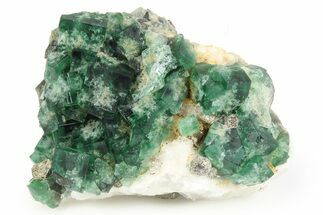This Specimen has been sold.
3.4" Aragonite Encrusted Fluorite Crystal Cluster - Rogerley Mine
Here is a nice 3.4" cluster of Rogerley fluorite from the famed Rogerley Mine in County Durham, England. This particular kind of fluorite is unique in that it will actually fluoresce a beautiful purple-blue color in just natural light alone! Under short and long wave UV, these crystals fluoresce a vibrant purple color.
One half of this specimen is encrusted in a layer of white aragonite that fluoresces orange under short wave UV.
One half of this specimen is encrusted in a layer of white aragonite that fluoresces orange under short wave UV.
The Rogerley Mine is located in the historic Weardale mining District of Northern England. First discovered in the early 1970s, the Rogerley Mine is the only mine in all of Britain to be worked on a commercial scale in the name of collecting crystallized mineral specimens. Since the summer of 1999, UK Mining Ventures has operated the Rogerley Mine on a seasonal basis, producing many fine, well crystallized specimens of green fluorite. Rogerley material is considered some of the finest fluorite in the world, and much of it has incredible fluorescent properties under both daylight and ultraviolet light.
About Fluorite
Fluorite is a halide mineral comprised of calcium and fluorine, CaF2. The word fluorite is from the Latin fluo-, which means "to flow". In 1852 fluorite gave its name to the phenomenon known as fluorescence, or the property of fluorite to glow a different color depending upon the bandwidth of the ultraviolet light it is exposed to. Fluorite occurs commonly in cubic, octahedral, and dodecahedral crystals in many different colors. These colors range from colorless and completely transparent to yellow, green, blue, purple, pink, or black. Purples and greens tend to be the most common colors seen, and colorless, pink, and black are the rarest.
Fluorite is a halide mineral comprised of calcium and fluorine, CaF2. The word fluorite is from the Latin fluo-, which means "to flow". In 1852 fluorite gave its name to the phenomenon known as fluorescence, or the property of fluorite to glow a different color depending upon the bandwidth of the ultraviolet light it is exposed to. Fluorite occurs commonly in cubic, octahedral, and dodecahedral crystals in many different colors. These colors range from colorless and completely transparent to yellow, green, blue, purple, pink, or black. Purples and greens tend to be the most common colors seen, and colorless, pink, and black are the rarest.
Aragonite is one of two common calcium carbonate (CaCO3) minerals: the other is calcite, of which aragonite forms as a pseudomorph. Its crystal lattice differs from calcite, resulting in a different crystal shape. It displays a translucent to white color when pure, and when impure can vary between yellow, green, pink, blue and brown. It typically forms in low-temperature hydrothermal veins, in hot springs, and as precipitates from chemicals in sedimentary rock. It can also form under biological processes: aragonite forms naturally in most mollusk shells, and as the calcareous endoskeleton most corals.
SPECIES
Aragonite & Fluorite
LOCATION
Rogerley Mine, County Durham, England
SIZE
3.4 x 2.7"
CATEGORY
SUB CATEGORY
ITEM
#143062
 Reviews
Reviews














